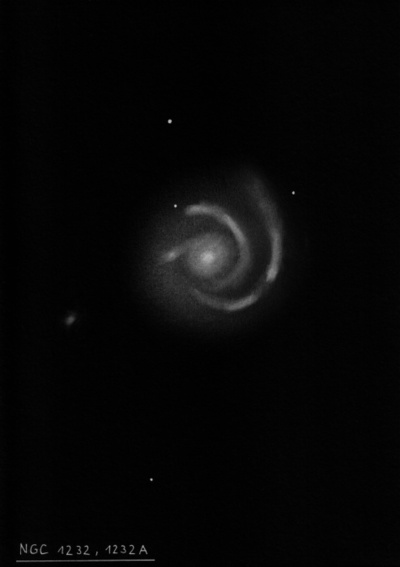
William Herschel discovered NGC 1232 = H II-258 = h2509 on 20 Oct 1784 (sweep 303) recording "eF, lbM, 7 or 8' dia." On 19 Dec 1799 (sweep 1091) he logged "F, cL, bM, irr F, 5 or 5' diam. The nebulosity is unequal, seeming to be two or three clouds or nebulosities joined together." John Herschel made 3 observations at the Cape. His most detailed observation reads, "B; vL; R; resolvable; 3' (dia), first very grad then psbM. With the left eye I see it mottled. (N.B. This is no doubt a distant globular cluster)."
Based on a photograph taken at the Helwan observatory in 1921-22, NGC 1232 was described as "pB, 7'x7', open spiral, B stellar nucleus, many branches with almost stellar condensations." NGC 1232B = PGC 11834, near the end of one of the spiral arms, was assumed to be interacting with NGC 1232, but its redshift places it four times the distance. Due to the apparent discordan redshift, NGC 1232/1232A was used by Arp to argue against redshift-based distances.
200/250mm - 8" (10/13/81): faint, diffuse, low surface brightness.
300/350mm - 13.1" (1/18/85): large, large bright core, substellar nucleus, very diffuse outer halo. An arm is suspected attached at the west end and winding towards the east on the north side of the core.
400/500mm - 17.5" (10/8/88): bright, large, slightly elongated, bright core, very large faint halo. Located 8' WSW of mag 8.6 SAO 168347.
600/800mm - 30" (10/15/15 - OzSky): NGC 1232 is a face-on multi-arm knotty Sc-type. At 303x it appeared very bright, very large, roundish, at least 6' diameter. It was sharply concentrated with a very bright, elongated core that contained a brighter central bar-like nuclear region. Spiral structure was evident in the large halo, but more subtle than I expected as several segments were disconnected. The most prominent was a knotty arm on the north side. It emerged near the northwest end of the core and shot linearly (2' length) towards the northeast in the direction of a mag 14 star 2.5' NE of center.
Another spiral arm extended east and west perhaps 1.5' length, just south of the central region. The arm faded out at its west end but after a short break, a very faint elongated knot, ~14"x8", was visible 1.7' WSW of center. NED includes multiple designations NGC 1232:[HK83] 442, [HK83] 445, [HK83] 450 and more from Hodge and Kennicutt's 1983 "Atlas of HII regions in 125 galaxies". The arm dimmed again but could just be traced shooting straight N-S in the northwest end of the halo. Another short, linear segment of a arm (containing [HK83] 110) was just visible close east of the core, 1.1' ENE of center.
NGC 1232A (the subject of a long-standing redshift controversy) was visible 4.1' ESE of center, just beyond the east edge of the galaxy. It appeared very faint, small, round, ~20" diameter
Notes by Steve Gottlieb